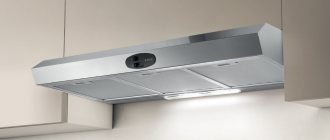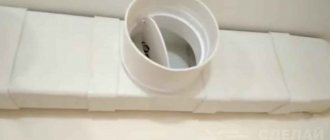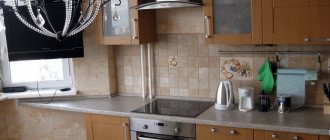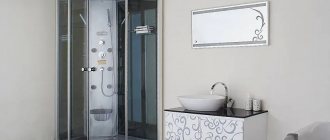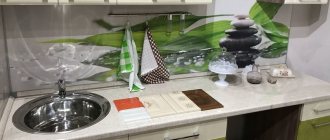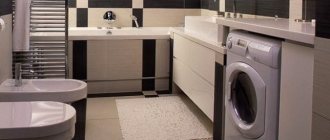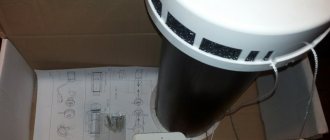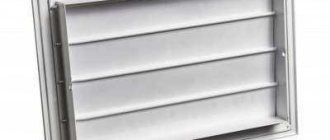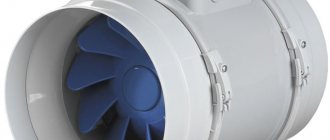A beautiful, stylish kitchen-dining room is a necessity for every family, but it requires careful cleaning. The times when the kitchen was simply whitewashed and repainted every year are gone. The cooking process is always accompanied by the release of moisture and combustion products that settle on the walls, furniture, and ceiling. A hood helps get rid of this problem.
But another problem arises: the hood and exhaust pipe in the kitchen do not look very aesthetically pleasing, they try to disguise them and make them as compact as possible. We welcome our dear regular reader and offer an article on how to select and install an air duct from a range hood with your own hands.
Use of ventilation pipes in everyday life
Residential buildings must have ventilation. In the process of breathing, a person emits carbon dioxide and moisture, cooking - moisture, soot, fat, carbon dioxide, sanitary appliances - a lot of moisture. Moisture settles on walls and furniture, which leads to the formation of mold. Carbon dioxide and combustion products, odors from cooking lead to rapid fatigue, irritation of the respiratory tract, deterioration of well-being, and decreased performance. Some of the substances formed during frying are carcinogens.
In old Soviet-built houses with small apartments and loose doors, ventilation in the kitchen and bathroom simultaneously removed some of the air from the living rooms. Ventilation ducts were built into the building structure. In private houses, ventilation was not provided at all - the situation with carbon dioxide was saved by a stove with a chimney: the air for firing the stove was taken from the house and removed, along with the products of fuel combustion, outside the living space. Fresh air entered houses and apartments through leaks in wooden windows and doors. The smoke and soot simply settled on the walls and ceiling - they had to be whitewashed every year.
In apartments there are ventilation ducts in kitchen hoods, additional ventilation in bathrooms and toilets.
In modern houses, in addition to the hood, additional ventilation systems are often installed - exhaust and supply and exhaust. In passive and energy-efficient houses, supply and exhaust ventilation with heat recovery is a mandatory component of the house design.
The role of the check valve in the system
The presence of check valves in the system will prevent air from entering the room from the ventilation duct. To avoid popping noises, it is necessary to install the valve axis perpendicular to the floor. The damper can only open when the hood is running.
Among the variety of similar products, 3 types of valves are most often chosen:
- Reverse petal. This is a series of blinds oriented vertically or horizontally when not in use. They open when the forced exhaust is turned on. Typically, walls with inlet openings are chosen for their installation.
- Turning. This is a simple mechanism that regulates the intensity of the flow or blocks it completely. It is made in the form of a block with a valve located on an axis and controlled using a system of counterweights and rods manually or using automation.
- Bivalve "butterfly". The body of this product contains an axis on which there are two dampers. When the fan is turned on, the dampers open; when the fan is turned off, they return to their original position.
Often, by connecting an exhaust structure to a ventilation duct, they completely block the path of clean outside air entering the building. Then, when the hood is not working, the room is not ventilated at all.
To prevent this from happening, a special grill must be installed on the opening of the ventilation shaft. At the top of it there is a pipe for connecting the exhaust pipe and at the bottom there are holes through which air flows naturally.
The photo shows a check valve. It works well with or without an exhaust fan. Blocks the flow of air from outside
Plastic ventilation pipes for hoods for both geysers and stoves are sometimes sold complete with the hood itself. The components of such a system are selected according to color and texture, so you don’t have to think about how to disguise or refine the pipes.
Differences between a kitchen exhaust system and ventilation
A kitchen hood is a local exhaust ventilation system with artificial impulse and is fundamentally no different from ventilation. There are differences from general indoor ventilation: general ventilation in apartment buildings is designed with natural impulse and operates without the participation of fans. In addition, general ventilation serves to ensure air exchange throughout the entire apartment, and the hood removes polluted air in a specific place and only when necessary.
Calculation of diameter and dimensions
The diameter must correspond to the cross-section of the outlet pipe on the hood. Since the dimensions of the outlets and pipes are standardized, this is easy to achieve. For plastic it is 10, 12.5, 15 and 20 cm, for corrugated pipe – 10, 12.5 and 15 cm. It is recommended to take a pipe whose cross-section is slightly larger than the cross-section of the pipe.
The ideal length of the air duct is no more than 3 m. If the pipe is longer, install a more powerful fan.
Valera
The voice of the construction guru
Ask a Question
It is usually not necessary to calculate the diameter of the pipe, since it is determined by the pipe and the ventilation hole. In rare cases, when the hood is not equipped with a fan, multiply the volume of the kitchen space by 12 - this is the recommended air exchange, and by 1.3 - the power loss coefficient. The resulting value is multiplied with the cross-section of the pipe and the maximum rate of air removed. As a result, the minimum permissible pipe cross-section is obtained.
The importance of kitchen ductwork
The existing general ventilation does not remove combustion products and evaporation specifically from the stove; it serves to replace air throughout the entire volume of the room.
Modern housewives are not happy with this situation. We want high-quality and durable repairs in the kitchen; a working woman does not have time to regularly wash the walls, ceiling and furniture. Demand creates supply - local ventilation units have appeared above kitchen stoves - hoods. But polluted air must be removed outside the room, and air ducts perform this function.
Advantages and disadvantages
There is only one advantage of the air duct: it is impossible to remove carbon dioxide, water and soot without it.
Disadvantages of air ducts:
- They take up space.
- They spoil the kitchen interior.
- Poor installation results in increased fan noise.
- They require regular washing on the outside and periodic cleaning on the inside.
Is it always possible to install a hood?
There may be situations when installing a hood is prohibited by the operating rules for gas appliances.
If there is a gas water heater (boiler) or a gas heating boiler with an open combustion chamber in the same room as the hood, a hood with air removal (circulation) cannot be installed. Removal of combustion products from the boiler occurs without force; when the exhaust fan is turned on, the draft may overturn and toxic combustion products may be thrown into the room.
It is allowed to install a flow-through exhaust device only if a boiler with a closed firebox is installed (with a coaxial chimney and combustion air intake from the street).
You can install circulation-type devices with filters that clean the air from grease and soot.
Is it possible to do without an air duct?
Hoods are produced as flow-through and circulating:
- Flow-through systems remove exhaust air from the room.
- Circulating filters purify the air without removing it from the room.
Circulating hoods are installed above the stove; the air passes through a housing with a carbon filter and is cleaned of grease. These devices do not require air ducts; they are compact and easy to install. But they have other disadvantages - the need to frequently change filters, insufficient air purification, and lack of removal of moisture and carbon dioxide.
Brief overview of materials
The range of pipes, both flexible and rigid, is very large, it is not difficult to work with them, so they are highly appreciated by consumers. They are confidently displacing steel analogues from the sphere of private construction.
For their production, polymers such as polypropylene (PN), polyvinyl chloride (PVC), polyurethane (PPU), fluoroplastic (PVDF) are used. PVC pipes are in greatest demand.
Dismantling PVC pipes
This inert polymer has sufficient rigidity. Its elasticity is increased by introducing plasticizers into the composition. Its glass transition temperature is quite high - 75⁰С.
Under normal conditions, the decomposition of the material takes decades, but at temperatures from 160 to 180⁰ C it begins to deteriorate very quickly. Because of this, it cannot be used for ventilation in rooms such as saunas, where the steam temperature sometimes reaches 200⁰.
A rectangular PVC pipe is connected through adapters. When air passes through it, it remains motionless, so the hood makes almost no noise
When the material decomposes, carbon monoxide (CO) is released, the inhalation of which is accompanied by suffocation, hydrogen chloride (HCl), which in an environment with high humidity forms hydrochloric acid - an invisible liquid that makes itself known with a pungent odor.
The compound has a very negative effect on health, in particular on the condition of the respiratory tract. In severe cases, vision may deteriorate sharply.
From this we can conclude: PVC pipe is excellent for kitchen hoods, but only in those places if the temperature threshold does not exceed +120⁰С. Negative temperatures are also contraindicated for these pipes.
Polypropylene ventilation pipes
Polypropylene is a durable polymer, the hardest of plastics and easily transformable. Its softening occurs at 140⁰С. Polypropylene does not withstand negative temperatures well - it immediately becomes brittle and brittle, therefore it is only suitable for internal use.
For the hood, polypropylene pipes with the designation PN10 are used. This type is characterized by such dimensions as outer diameter - 2-11 cm, wall thickness - 0.19-1 cm.
Polypropylene is safe, reliable and simply an ideal material for molding. The photo shows ventilation pipes and plastic ventilation elements
Pipes made from polypropylene are single-layer and multi-layer.
The first include products marked:
- RPH - made of homopropylene;
- PPV - the material for production is a block copolymer of polypropylene;
- PPR - made from a statistical copolymer of polypropylene;
- PPs - low-flammable material was used in manufacturing.
Multilayer pipes are reinforced with foil and fiberglass. They have increased rigidity and a low coefficient of thermal expansion. Products made from polypropylene are less strong than PVC, so they have thicker walls and are more expensive.
Polyurethane ventilation pipes
The characteristics of polyurethane pipes are in many ways similar to those of PVC pipes. They are plastic and wear-resistant, they can be given any shape.
The main difference is the ability to remain unchanged until the temperature reaches 280⁰C. When this threshold value is exceeded, polyurethane becomes very hazardous to health because it releases nitrogen compounds.
Cracks will not appear on a polyurethane pipe even under the influence of high voltages. It can be bent as you like, but as soon as the load disappears, the original shape of the product returns
They are used in areas with complex trajectories, many turns and shifts. The aerodynamic characteristics of these pipes are somewhat reduced by the presence of roughness on their inner surface. The cost of such pipes is quite high.
Characteristics of fluoroplastic pipes
Pipes made of this material have high strength characteristics. They have proven themselves well in the temperature range from -40 dl +140⁰С. Fluoroplastic is recognized as the most slippery polymer; this fact is even recorded in the Guinness Book.
PTFE pipes are exceptionally resistant even compared to noble metals. This material does not lose its characteristics in extreme conditions
They are resistant to aggressive alkaline and acidic vapors, therefore they are indispensable for exhaust systems in chemical industrial plants. The diameter of the products ranges from 15 to 60 cm.
Due to their high cost, it is irrational to use them in the private sector. Another limitation for their use is their increased gas permeability.
Types: materials and characteristics
For the installation of small home ventilation systems, the industry produces a wide range of pipes and components.
Air ducts for domestic ventilation are divided into:
- By material - plastic, aluminum or galvanized steel.
- Shape: square, rectangular, round.
- According to the degree of flexibility - flexible or rigid. Flexible boxes are made of corrugated aluminum or galvanized steel. Rigid air ducts made of metal are not used due to the complex installation and complexity of manufacturing galvanized pipes of small sizes (from 100 to 150 mm in diameter or section side length). Aluminum pipes of suitable sizes are expensive, there are no special advantages in their installation, so they are also not used for kitchen hoods.
Plastic
Plastic air ducts are round, square and rectangular with a smooth surface. They come in white and painted in different colors - it’s easy to choose a shade that matches your furniture set or wallpaper.
Plastic boxes are very smooth - they are easy to clean, and less grease and soot accumulate inside. Smooth walls provide the least air resistance - therefore, such pipes vibrate and make less noise. Plastic boxes are the quietest compared to corrugated boxes.
.
Made from flexible corrugated aluminum pipe
A very practical option for an air duct is a corrugated aluminum pipe of round cross-section. The flexible pipe is easy to install; it does not require rotating elements - it can simply be bent. An aluminum pipe is durable, but it is very difficult to clean it from grease and soot deposited on the walls. The corrugated inner surface creates great resistance to air flow; the pipes make more noise when the hood is operating.
Metal
The corrugated pipe can be made of galvanized steel. This pipe is a little stiffer and stronger, but otherwise its installation is as simple as for aluminum corrugation.
Places with a damaged zinc layer rust, the rigidity of the pipe complicates its installation, so steel corrugation is rarely used for internal household ventilation systems.
By degree of flexibility
Aluminum corrugation is more ductile than steel, it is easier to bend, stretch and compress.
Plastic air ducts are used only for rigid ones; corrugated plastic pipes are not suitable for transporting hot air.
Varieties
The air ducts used for kitchen hoods vary in material, shape and level of rigidity.
Exhaust pipes are made from several types of plastic:
- PVC;
- fluoroplastic;
- polypropylene;
- low density polyethylene.
The first 3 types are suitable for connecting to an exhaust device in the kitchen: they are resistant to high temperatures.
Products for kitchen hoods can be corrugated (flexible), as in the following photo, or made of hard, smooth plastic.
There are air ducts with a rectangular or round cross-section.
- Rectangular plastic channels are compact, easily hidden under a suspended ceiling, and more convenient to install.
- Round exhaust pipes have higher throughput and lower noise levels.
Advantages of plastic and metal air ducts
Advantages of plastic boxes:
- Little air friction and power loss when air passes through pipes.
- Easy to clean; Less grease and soot settle.
- Fits beautifully into the interior.
- There are many varieties of components available that allow you to assemble a system of any configuration.
Advantage of metal corrugation:
- Fewer adapters and angles required; smooth turns reduce the efficiency of the system less.
- The ability to stretch and contract makes installation easier.
- Small price.
Which option is better
Plastic boxes are better - they have less resistance to air flow, they fit better into the interior and are washable.
But in some cases, when laying hidden, flexible corrugated pipes are necessary.
Plastic ventilation from sewer pipes
Experts often argue whether it is possible to make a plastic hood from sewer pipes. Opponents of this idea cite an argument such as the lack of antistatic coating in these products, as a result of which their internal surface is not protected from the deposition of dust and dirt. Proponents say the problem will be solved by doing the procedure yourself.
The material for the manufacture of plastic sewer pipes is the same type of plastic, except that its quality is slightly lower. They are cheaper, so many people use them for hoods.
The undeniable advantage of pipes for sewerage installations is that their price compared to plastic air ducts is 3 times lower. The disadvantages of these pipes and special ventilation products are common - loss of rigidity at high temperatures.
When using pipes intended for sewer construction as a supply air duct, sometimes a characteristic plastic smell is felt, but after a while it disappears. The pipes also differ in their weight, which is slightly greater than that of air ducts. For them it is necessary to provide fastening.
Image gallery
Photo from
Stage 1: Bringing plastic ventilation out
Stage 2: Drilling holes to fix the brackets
Stage 3: Installing the bracket into the dowel
Stage 4: Complete exhaust duct assembly
Tips for choosing
When choosing a pipe type, they are guided primarily by aesthetic considerations. Before making a choice, it is determined whether the box will be mounted openly or covered with furniture, a box, a false wall, or a suspended ceiling.
Corrugated shiny pipes spoil the kitchen interior; more often, when laying air ducts openly, smooth plastic pipes are chosen - they are easy to clean and can be painted in the desired colors - white or colored to match the ceiling or walls. Rectangular and square boxes fit better into the interior; round plastic boxes have minimal resistance to air flow.
When laying hidden, corrugated pipes are chosen - they are easier to install, no adapters or corners are needed, they are easier to bend when avoiding obstacles and for turning. Masking metal pipes will require additional costs. If problems arise, it will be difficult to get to the hidden pipe.
Diameter and shape
The diameter of the round pipe should be equal to the diameter of the outlet pipe of the kitchen hood.
Round boxes provide minimal resistance to air movement.
The ideal shape for an air duct is straight. Sharp corners when installing air ducts are unacceptable.
Dimensions and cross-section
The cross-section of a square or rectangular pipe must be equal in area to the cross-section of the round hood pipe. Narrowing the cross-section will lead to deterioration in system performance, fan overload, increased noise, vibration and loosening of fasteners. It is better to take a pipe with a slightly larger cross-sectional area. A large excess of the cross-section will lead to increased costs and difficulties with masking the pipe.
A slight narrowing of the cross-section is permissible only if the fan power is taken “with a reserve” and the hood is rarely turned on at maximum power.
Optimal duct length. If the duct length is longer, the fan power must be increased.
Diameters of corrugated pipes used in domestic ventilation: 100 mm, 125 mm, 150 mm.
Dimensions of plastic boxes: 80×80 mm, 100×100 mm, 125×125 mm, 55×110 mm, 50×120 mm, 60×204 mm, 90×220 mm.
Diameters of plastic pipes: 100 mm, 125 mm, 150 mm, 200 mm.
Calculation of the minimum required size
Calculation of the cross-section of the hood duct is not necessary. The cross-section should be equal to the cross-section of the hood outlet pipe. If the hood was purchased with a power reserve and it is not planned to turn it on at maximum power, then the cross-section can be narrowed.
The minimum cross section is calculated using the formula:
Smin=Srab *(QrabQmax), where
- Smin is the minimum possible cross section.
- Srab is the nameplate section of the exhaust pipe.
- Qwork is the required volume of air removed.
- Qmax - maximum volume of air removed (according to the hood's passport).
- Qwork is calculated using the formula:
- Qwork = kitchen volume x 12 times x 1.3 per m³.
In accordance with sanitary standards, 12 is the air exchange coefficient (the air in the kitchen should be changed 12 times per hour), 1.3 is the power loss coefficient in the air duct and ventilation shaft.
Duct requirements
All technological conditions are specified in regulations, for example, in GOST 12.4.021-75 SSBT “Ventilation systems”. And they can also be developed separately by designers for the immediate home. The main task is to remove exhaust air. The performance of air channels in this case consists of three components: the strength of the air exhaust pipe, its configuration and diameter. The air distribution system must pass the required amount of air subject to certain requirements:
- pipe tightness;
- minimal air leaks;
- speed of exhaust air in accordance with SNiP;
- noise level is not higher than sanitary standards;
- thermal insulation (if necessary).
And also during installation it is necessary to minimize the space in which the exhaust duct is installed. The pipe shape, material and diameter are then selected based on the influence of immediate conditions.
Connection rules for all types of pipes
Recommendations:
- The duct must be carefully sealed at all joints.
- The system must contain a minimum number of adapters, turns, and narrowings - they lead to a decrease in efficiency.
- The boxes must be securely attached to the walls and ceilings using special clamps. If the boxes are moving, the system will vibrate, the noise level will increase and the seal will be broken.
Rules for laying the air duct from the hood to the ventilation shaft opening
For proper installation of the air duct, it is necessary, if possible, to select the shortest path from the hood to the hole in the ventilation shaft. If the air duct is too long, you need to consider another possible way to remove polluted air - for example, to the street.
The shape of the air ducts should have a minimum of turns. . If possible, it is necessary to smoothly rotate the pipe using two 135° bends or different-angle bends (see 6 in the figure). You cannot turn the box at an acute angle - this will completely stop the movement of air in the pipeline.
If the length of the air duct is too long, it is necessary, with the help of specialists, to recalculate the power losses in the air duct and the required fan power.
Features and nuances of do-it-yourself installation
Installing ventilation pipes from a hood is a simple task, quite feasible for a home craftsman even with little experience. If you carefully follow our advice, the installation of ventilation ducts will go without problems.
Required tools and materials
To complete the work you will need:
- Drill.
- Screwdriver.
- Hacksaw or grinder.
- Sealant.
- Boxes, bends, adapters of the required section.
- Check valve.
- Ventilation grille for connecting ducts to the ventilation shaft.
Indoor air duct installation
To install the boxes, it is necessary to carefully mark and measure the entire route of the system. The grate on the hole in the shaft is dismantled, and if necessary, the shaft is cleaned of dust, soot and cobwebs.
After installing the exhaust equipment, connect the box to the exhaust pipe. All joints are coated with sealant. Heat-resistant sealant is not needed - the temperature of the exhaust air is not too high.
Then the system is assembled by inserting individual elements into one another. The pipes are shortened to the required length by cutting with a hacksaw or grinder. The box is fixed to the wall using special holders or clamps. The distance between fastenings is no more than 500 mm.
The grate is attached to the shaft wall with dowels. It is more practical to use a grille with a hole for the box and a hole for natural ventilation. A check valve must be installed in the system - if the hood is not working, it will prevent air from flowing back into the room from the ventilation shaft.
To install the system, only industrially produced pipes, adapters and connectors are used - there is no need to reinvent the wheel, the industry produces fittings for any geometry of ventilation ducts and transitions from round to rectangular pipes.
After installation of the system, it is tested:
- If a leak is detected, coat the gap with sealant.
- If rattling occurs when the system comes into contact with any structures, in this case it is necessary to lay a gasket made of polystyrene foam or polyethylene foam.
Thermal insulation of pipes in the attic
Water must not enter the air ducts. If water gets in, the fan will quickly fail. In order to prevent moisture from settling on the walls of ventilation pipes and ducts, it is necessary to provide insulation. For this purpose, slabs of polyurethane foam or mineral wool are used. The insulation is covered with roofing felt or fiberglass on top and secured with wire.
How to hide equipment
The hood can be covered with a decorative screen or an imitation of a kitchen hanging cabinet.
How to hide pipes from the kitchen hood
There are several options for hiding pipes:
- Covering suspended ceiling structures.
- Route through kitchen cabinets.
- Laying over cabinets and covering with a decorative screen.
- Painting or decor to match the color of the walls and ceiling.
- Closing with decorative boxes.
- Covering with a screen that imitates a wall, for example, made of plasterboard.
When installing boxes behind a false wall or suspended ceiling, you should take into account the fact that disassembling and cleaning or repairing the system will not be easy - you will have to disassemble the wall or dismantle the ceiling structures.
Installation of a hood without a duct
Circulation-type hoods are more compact than flow-type hoods, and their installation is simpler. A hood without pipes is simply attached to the wall or suspended from the ceiling (if the stove is placed in the middle of the kitchen on the island).
Video
All the details of installing a hood box can be seen in our video:
How to hide a pipe
The ventilation pipe does not always fit into the interior. To disguise it, use the following methods.
- Imitation of a kitchen hanging cabinet - if the outlet to the shaft is located close, the entire pipe can be hidden in the cabinet.
- If the ventilation is located high, you can hide it under the suspended ceiling.
- The pipes are painted in the color of the wall or kitchen apron, and painted with patterns.
- Communications can be hidden in a decorative box . The latter is easiest to make from drywall.
Decorative screens, boxes and other methods of disguise must comply with the rules. Access to ventilation must remain free.
Duct outlet options
There are several options for using and connecting the air duct in the kitchen:
- Connect one or two air intake points to one air duct.
- Take the box outside or into a ventilation shaft.
In any case, general ventilation must operate in the room.
With one entrance
When connecting one air intake point to the ventilation system, the possibility of natural ventilation must be provided. If there are two ventilation shafts in the kitchen, the hood is connected to one of them, and a hole (with a grill) is left in the second shaft for natural ventilation.
If there is only one shaft, then a tee is installed near the entrance of the hood pipe to the ventilation shaft with the ability to switch between the hood and the hole for natural ventilation. There are grilles with holes for natural ventilation and a check valve that does not let air from the shaft back into the room.
With two inputs
If it becomes necessary to connect two air intake points to one system, then check valves must be installed between the tee and the fans, otherwise the fans will interfere with each other’s operation. It is also advisable not to turn on the fans at the same time. A third check valve is installed near the grille.
Outside
If you decide to take the box outside, you need to cover the outlet hole with a grill to prevent birds or animals from getting into the pipe. It is also necessary to install a check valve to prevent cold air from entering the room.
Installation features
The installation of an exhaust system depends on the material it is made of, as well as on the location of the ventilation in relation to the placement of the hood.
- The first thing to consider when installing an air vent: the hood should not be located opposite the ventilation. This is the most inergonomic arrangement, in which it is impossible to ensure normal air removal.
- Second: the closer the hood is to the ventilation duct, the higher the efficiency of air removal will be.
- Third: the absence of sharp corners in the duct design has a beneficial effect on its efficiency.
- Fourth: it is necessary to install additional ventilation (for example, grilles), since one channel will be occupied by the hood.
Installation of corrugated aluminum ventilation ducts
Convenient and maneuverable when laying a ventilation duct of any complexity. You can mount it at the required angle. There is no need to use rotating shaped elements. These types of pipes are sold in small pieces. You can stretch the “accordion” up to 3 meters. This length is enough to install a kitchen ventilation duct. Don't make channels too long. This contributes to a decrease in ventilation performance in general.
Steel accordion duct is suitable for simple systems
Important! Corrugated aluminum air ducts can withstand temperatures from -30 to 250 degrees. Therefore they are considered fireproof.
The corrugation easily attaches to the hood pipe, as it has a standard size. The clamp easily secures this connection. If the cross-sectional diameter is rectangular, then the corrugation can be easily bent, giving it a rectangular shape. You can go the other way and buy an adapter.
A prerequisite for installing a flexible pipe is stretching. The air passing through encounters resistance in the form of an “accordion” along its path. In such pipes, waste products settle inside, so over time, plaque and a decrease in clearance are guaranteed. Additional moisture can also form on the ventilation duct - this is condensation that appears due to temperature differences. Aluminum is a conductor of heat, so dew points will appear during the winter. A pipe in an extended position can be easily deformed. Therefore, it is better to hide it under a decorative box.
Select duct size
Hood performance is reduced by two factors:
- The presence of 90 degree turns (sharp corners are not allowed at all).
- Reducing the cross-sectional area of the ventilation tract.
How does what has been said relate to the everyday life in which we live? The ventilation ducts of most buildings traditionally have a diameter of 14 cm. Square shafts are built with a side of 13 cm. It is not difficult to guess that when connecting an air duct with a smaller cross-section, we partially use the passage. Rework will become the bottleneck of the channel. Conversely, an air duct with an excessively large cross-section will not bring much benefit, since the duct narrows further. It would be correct to evaluate the dimensions before choosing a hood. You should buy an umbrella or air ducts after understanding how well the products will work together.
Avoid installing air ducts incorrectly
The Ukrainian channel Inter showed the installation of a hood using round, rectangular air ducts. The perimeter of the kitchen was a row of hanging cabinets. It was decided to strengthen a flat hood under the section. In the furniture located vertically above the stove, two holes were made with a milling cutter, accommodating a round air duct of 125 mm in diameter. Holes were punched through the floor and ceiling of the closet. The installation was carried out using a plastic air duct.
The hood was strengthened close to the section, under the bottom. A section of round air duct passed right through the cabinet, extended from above, and was connected with a special transition segment: the bottom side contains an inlet hole with a diameter of 125 mm, and on the side there is a rectangular outlet. A flat air duct ran from the segment to the ventilation hole for exhaust through the cabinets. Along the plastic path, the channel is invisible from the outside, the appearance of the kitchen remains the same. The rectangular air duct was connected to the ventilation hole by another segment similar to the one mentioned. The connecting element was a round section equipped with two turns, tightly gripping the opening of the ventilation network.
Types of plastic air ducts
Beautiful, but contains three serious errors from a practical point of view:
- Looking for a way to free itself, the air will travel through four 90-degree bends. Each turn reduces the efficiency of the hood by 10%. Four bends:
- directly above the hood on the joint segment;
- two corner turns on the second joint segment;
- bend inside the ventilation system.
Forty percent of efficiency is lost.
- A rectangular air duct with a smaller cross-section than a round one will significantly reduce the performance of the hood.
- The main drawback: the ventilation system was destroyed.
Let's look at three points in more detail. As for the number of turns, while paying tribute to the appearance, our installers lost 20% of the power just due to unnecessary bends. Obviously, the best solution was to use a round aluminum corrugation with one bend above the hood. Visible above the cabinet, it can be easily corrected with a decorative panel made of plasterboard or other material.
A flexible exhaust duct would be suitable to avoid losses when switching to a smaller rectangular cross-section. How to proceed. Find a segment with access to a square air duct of a similar cross-section or carry out work on a round one. It is harder to hide the channel, but the efficiency is maximum.
The main thing is the third point.
Connection options when assembling ventilation ducts
Air ducts are assembled from individual parts. Docking is carried out using flanges or other connecting elements.
Angular flanges are installed at the ends of the sections being connected. Holes for mounting bolts are drilled on them. Sealing gaskets are placed between the flanges.
To ensure the strength of the flange connections, the bolts are carefully tightened using nuts and a suitable wrench. The nuts are on one side of the connection. When installing vertical pipes, the nuts are located on the side of the lower flange.
The disadvantages of such a connection are the significant weight of the structure, high consumption of metal, and high labor intensity of the work.
A sealing tape is placed between the flanges of the parts to be connected. Its edges should not extend into the inner space of the pipe and cover the holes for the bolts. To make the oil seal, dense or porous rubber or foam rubber is used.
Lighter flanges are made from galvanized profile strip. The Z-shaped flanges are connected using a C-shaped rail and a seal.
The connecting rail resembles a collapsible flange. It is made of a galvanized metal profile in the shape of the letter G. The length of the larger side is from 20 to 30 mm. The kit includes a seal and a corner. The advantages include low labor intensity and low financial costs.
Among the wafer connections used for assembling round air ducts, the most commonly used are:
- nipple;
- bandage.
The thickness of the nipple should not be less than the thickness of the pipes.
The nipple is inserted inside or put on top of the joining elements so that its width covers both sides of equal length for the pipe diameters:
- 100 - 315 mm - not less than 50 mm;
- 355 – 800 mm – not less than 80 mm;
- 900 - 1250 mm - not less than 1000 mm.
Instead of the name nipple, the term coupling is often used.
The tightness of the nipple connection is ensured by the rubber gasket included in the delivery set. In its absence, the fastening is sealed with adhesive tape with a polymer or reinforced coating. Every 200 mm of circumference, the coupling is tightened with rivets or self-tapping screws with a diameter of 4-5 mm. The number of fasteners should not be less than three
The bandage connection is considered a connection with a high degree of strength and reliability. The edges of the straight and shaped parts of the air ducts are folded back and combined. Then a bandage filled with sealant is applied to the pipes at the seam and tightened.
When connecting air ducts, the seams are sealed:
- elastoplastic tapes such as “Guerlain” at temperatures up to 40 degrees;
- non-hardening mastic based on synthetic rubber (for example, Buteprol), silicone and other sealants that can withstand heating up to 70 ° C.
The seam of the pipe or box is located at the top.
When moving an air mixture with a temperature above 70 ° C, elastic strands made of polyisobutylene, bitumen mastic (BTU) and other fire-resistant non-combustible materials are used as a seal.
Before joining the channel elements with thermal insulation, carefully bend the insulation at both ends. The sections are hermetically connected and the insulating layer is returned to its place. The seam in the thermal insulation is sealed with aluminum tape or clamps.
Functional purpose and technological features
The task of any ventilation system is to maintain a fresh atmosphere in the house, remove foreign odors and substances that do not meet sanitary standards. Forced ventilation is rarely used in residential buildings. And for the natural movement of air to work correctly, it is necessary to create good draft in the exhaust air line. It is ensured by the optimal location of the outlet pipe above the roof and the correct calculation of its height.
Complete ventilation of the house should perform the following tasks:
- ventilation of all rooms in the building;
- air removal from household appliances (gas stoves and boilers);
- sewer line ventilation.
It is optimal for each task to create a separate ventilation circuit with its own exit to the roof.
Functions of home ventilation
How to make an air duct for a kitchen hood correctly
Of course, you need to know the general installation features:
- The length of the ventilation duct should be no more than 3 meters. Otherwise, the efficiency decreases to 10% for each next meter of pipe.
- You should not make a ventilation duct for the hood with many angles and turns. Their maximum number is 3 elements. Moreover, the bending angle must exceed 90 degrees. At every turn of the pipe, the air encounters resistance, which reduces efficiency by up to 10%.
- Air ducts with a round cross-sectional diameter create additional turbulence in the passing air, which cannot be said about ventilation ducts with a rectangular cross-section.
Important! The cross-sectional diameter of the exhaust pipe must be equal to the cross-sectional diameter of the connected ventilation pipe. Otherwise, the hood motor may burn out due to the additional load. Narrow ventilation ducts will reduce sound insulation.
Popular mistakes when installing a hood
We told you how to properly install a hood in the kitchen.
Now let's look at the mistakes that users often make when deciding to act on their own:
- Blind connection of an air duct with natural ventilation. Some owners, although they install a grill, still completely cover it with an air duct.
- For a powerful hood, use a small-diameter corrugation or pipe that does not coincide with the socket.
- Installing a hood in the kitchen above the stove without taking into account the height. Which can lead to a fire.
- Exiting the air duct to the street through a hole in the wall of the house. What is prohibited in apartments.
- Long duct with many turns. This affects both the operation of the device and the noise level.
- Installation of a powerful hood (800 m3/h and above) with a connection to conventional ventilation, which is capable of 300 m3/h.
- Connecting the channel parts with glue. After that, such a channel can no longer be disassembled.
- No outlet near the hood. And then you have to resort to tees and other methods of connecting the device to the network, which looks ugly and is inconvenient to use.
- Errors in installing the check valve. Angles and inclinations must be taken into account to ensure that the valve operates smoothly.
- Incorrect placement of slots in the grille. Sometimes you need them to be at the bottom, not at the top.
Increased ventilation system performance
The best way is to create forced air flow using roof fans. But it is very expensive and difficult.
At the same time, passive additions to the pipe can lead to improved air movement. Here are some of them:
- Deflector. Special attachment for the upper part of the ventilation pipe. Its internal structure, under the influence of wind, creates an area of low pressure at the very outlet of the air duct. This leads to increased traction.
Roof deflector
* - Protective caps and droppers. They are attached to the top of the ventilation pipe and prevent precipitation from entering it. The absence of moisture in the system maintains its performance and reduces the risk of corrosion.
- Roof aerators. Devices designed to improve ventilation between the roof itself and its thermal insulation. They do not directly affect the microclimate in the house, but prevent the formation of condensation.
Practice shows that protection from moisture and installation of a deflector can increase the draft in the ventilation pipe by 10 - 30% in different weather conditions.
